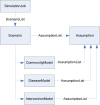Assumptions management in simulation of infectious disease outbreaks
- PMID: 20351844
- PMCID: PMC2815436
Assumptions management in simulation of infectious disease outbreaks
Abstract
Simulation of outbreaks of infectious disease is an important tool for understanding the dynamics of the outbreak process, the impact of disease and population properties, and the potential effect of interventions. However, the interpretation of the simulation results requires a clear understanding of the assumptions made in the underlying model. Typical simulation tasks, such as exploring the space of different scenarios for population and disease properties, require multiple runs with varying model parameters. For such complex tasks, the management of the assumptions made becomes a daunting and potentially error-prone undertaking. We report explicit assumptions management as an approach to capture, model, and document the assumptions for simulator runs. It was found possible to extend ontology-based simulation, which uses an ontological model to parameterize the simulator, to incorporate an assumptions model in the ontology. We conclude that explicit assumptions modeling should be part of any infectious disease simulation architecture from start.
Figures



Similar articles
-
Ontology based modeling of pandemic simulation scenarios.Stud Health Technol Inform. 2007;129(Pt 1):755-9. Stud Health Technol Inform. 2007. PMID: 17911818
-
Impact of precautionary behaviors during outbreaks of pandemic influenza: modeling of regional differences.AMIA Annu Symp Proc. 2009 Nov 14;2009:163-7. AMIA Annu Symp Proc. 2009. PMID: 20351842 Free PMC article.
-
Realistic assumptions about spatial locations and clustering of premises matter for models of foot-and-mouth disease spread in the United States.PLoS Comput Biol. 2020 Feb 20;16(2):e1007641. doi: 10.1371/journal.pcbi.1007641. eCollection 2020 Feb. PLoS Comput Biol. 2020. PMID: 32078622 Free PMC article.
-
An infectious way to teach students about outbreaks.Epidemics. 2018 Jun;23:42-48. doi: 10.1016/j.epidem.2017.12.002. Epub 2017 Dec 9. Epidemics. 2018. PMID: 29289499 Free PMC article.
-
Joint estimation of the basic reproduction number and generation time parameters for infectious disease outbreaks.Biostatistics. 2011 Apr;12(2):303-12. doi: 10.1093/biostatistics/kxq058. Epub 2010 Sep 21. Biostatistics. 2011. PMID: 20858771
Cited by
-
A cloud-based simulation architecture for pandemic influenza simulation.AMIA Annu Symp Proc. 2011;2011:364-73. Epub 2011 Oct 22. AMIA Annu Symp Proc. 2011. PMID: 22195089 Free PMC article.
-
Dynamic Multicore Processing for Pandemic Influenza Simulation.AMIA Annu Symp Proc. 2017 Feb 10;2016:534-540. eCollection 2016. AMIA Annu Symp Proc. 2017. PMID: 28269849 Free PMC article.
-
A neighborhood susceptibility index for planning of local physical interventions in response to pandemic influenza outbreaks.AMIA Annu Symp Proc. 2010 Nov 13;2010:792-6. AMIA Annu Symp Proc. 2010. PMID: 21347087 Free PMC article.
-
Requirements and design of the PROSPER protocol for implementation of information infrastructures supporting pandemic response: a Nominal Group study.PLoS One. 2011 Mar 28;6(3):e17941. doi: 10.1371/journal.pone.0017941. PLoS One. 2011. PMID: 21464918 Free PMC article.
-
Relevance of workplace social mixing during influenza pandemics: an experimental modelling study of workplace cultures.Epidemiol Infect. 2016 Jul;144(10):2031-42. doi: 10.1017/S0950268816000169. Epub 2016 Feb 5. Epidemiol Infect. 2016. PMID: 26847017 Free PMC article.
References
-
- Jenvald J, Morin M, Timpka T, Eriksson H.2007Simulation as Decision Support in Pandemic Influenza Preparedness and Response In Proc of ISCRAM 2007295–304.May 13–16 Delft, The Netherlands.
-
- Eriksson H, Morin M, Jenvald J, Gursky E, Holm E, Timpka T. Ontology based modeling of pandemic simulation scenarios. Stud Health Technol Inform. 2007;129:755–9. - PubMed
-
- Halloran ME, Longini IM, Cowart DM, Nizam A. Community interventions and the epidemic prevention potential. Vaccine. 2002 Sep 10;(27–28):20. 3254–62. - PubMed
Publication types
MeSH terms
LinkOut - more resources
Full Text Sources
